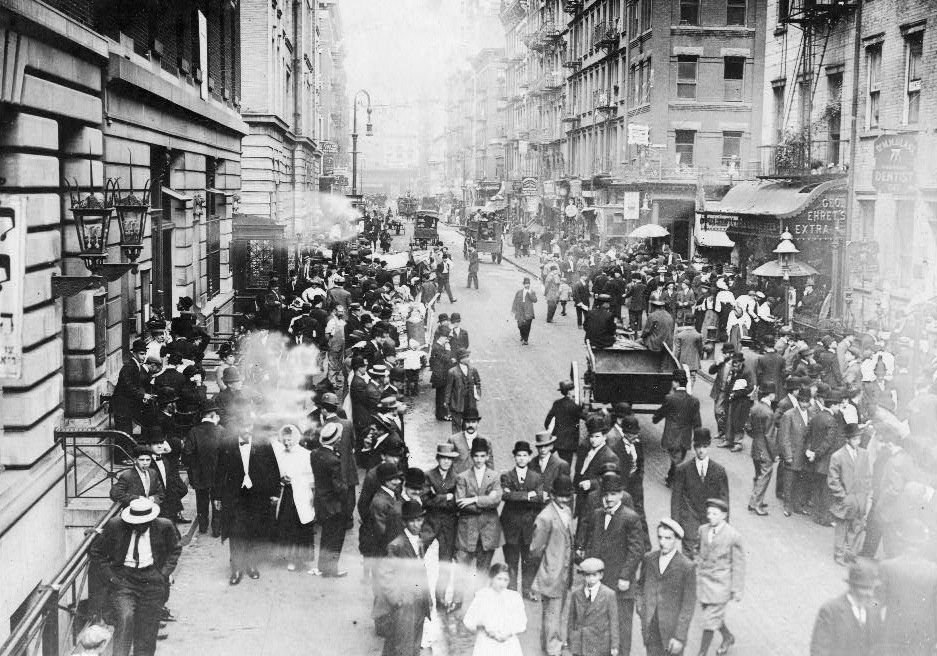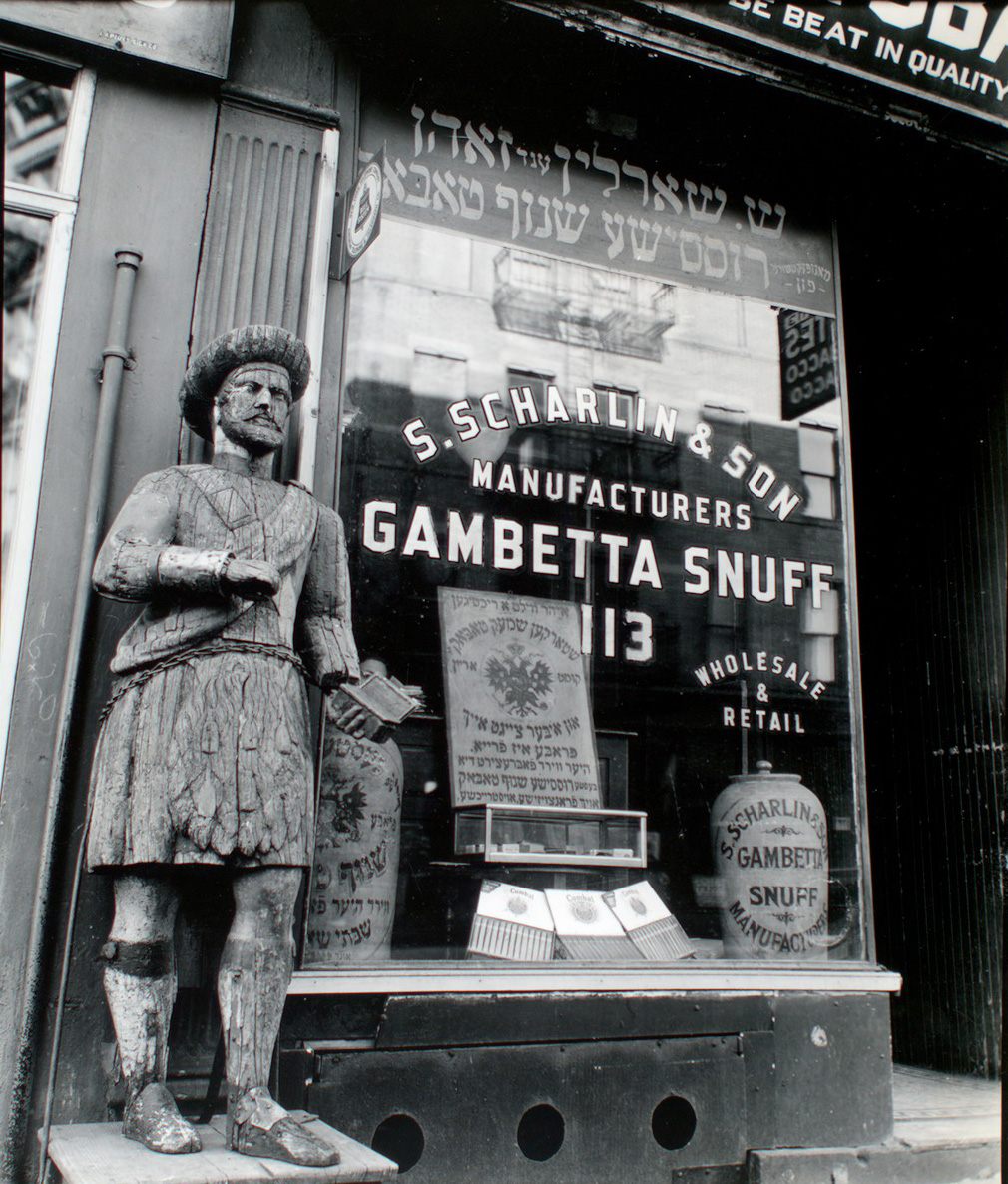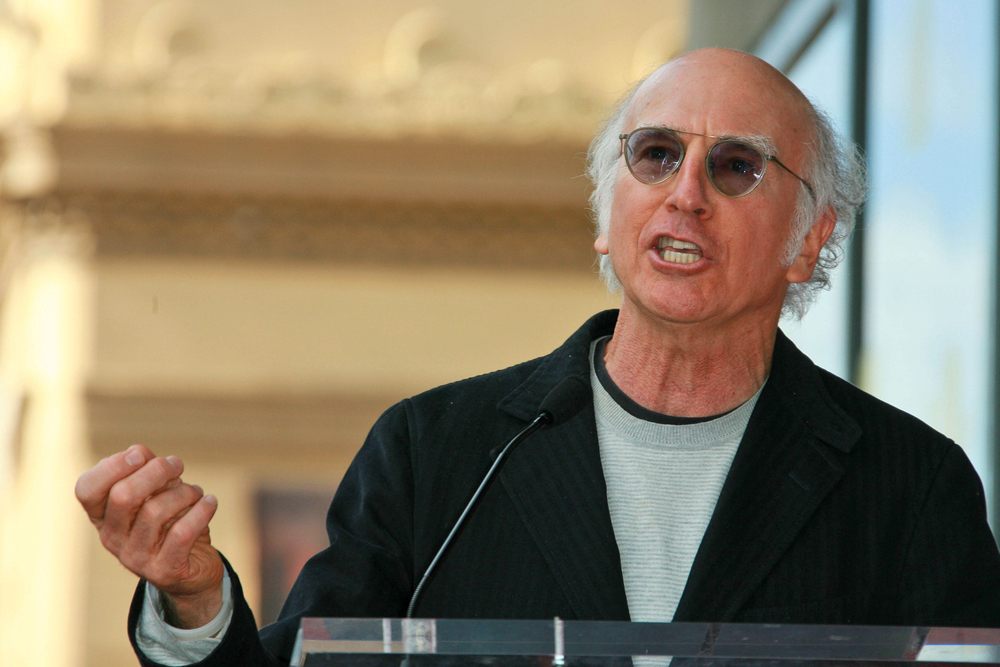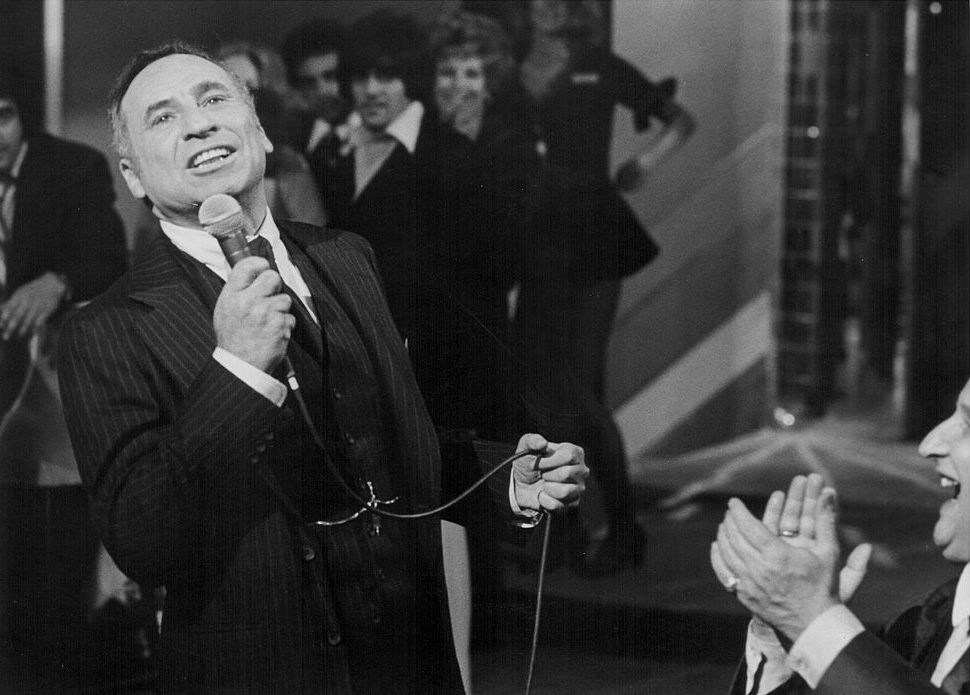Why Linguists Are Fascinated by the American Jewish Accent
The linguistic field of prosody, the story of melody, pitch, and other hard-to-study verbal traits, is suddenly hot.
Between 1880 and World War I, a wave of Eastern European Jewish immigrants crashed on America’s shores. They spoke Yiddish, and then English, with a special tone, a kind of sing-songy incantation. About a decade after they landed, linguists began paying attention. “People start noticing, huh, they speak English kinda funny,” says Rachel Steindel Burdin, a linguist at the University of New Hampshire who studies Jewish English.
The study of melody, pitch, pause and intonation is called “prosody” and it’s now a hot, if still esoteric, topic among the language set. But the Jewish prosody stylings would be familiar for anyone who’s heard some of the 20th century’s most famous comedians—Jerry Seinfeld, Woody Allen, Don Rickles and others have exploited its rich texture. Perhaps the greatest example is Mel Brooks, here as Yogurt in his 1987 movie Spaceballs, at 0:58:
There’s so much going on in just that tiny sentence, “You heard of me?” There’s a distinct New York City accent, if an outdated one, turning “heard” into “hoid.” (This feature, known as the coil-curl merger, is really only heard in New Yorkers born before World War II.) Beyond that, he doesn’t intone this query as a question in any typical American English; the pitch and emphasis of the question doesn’t resemble how a non-Jew would ask it. Brooks’s pitch shoots upward at the word “heard,” back down in “of,” and then slightly up again at “me.”
But is it really a religious or ethnic thing? Can we call it a “Jewish accent” rather than, say, a “New York accent”?
Scholars say, yes, there is an American Jewish accent, but it’s complicated. “Intonation has kind of been the red-headed stepchild of linguistics, where for a lot of time there was debate about whether or not it’s really part of the linguistic system, or whether it was something else overriding it, essentially,” says Burdin. It’s only been about 15 years since linguists—just a few of them, really—have begun systematically attempting to study the rhythm, timbre, intonations, stresses, and pauses of speech, and the study is still in its infancy. It is particularly murky territory in English, where melody is not as important as it is in other languages. But there are some groups whose speech, long having been described as sing-songy, is suddenly of interest to researchers breaking new ground in the study of prosody. Appalachian English is one of those. And Jewish English is another.
The first problem in talking about Jewish English is its definition. Jews, having been scattered around the globe for a few thousand years, constructed various cultures and languages, and so a random assortment of Jews in America does not guarantee that they’ll sound anything alike when speaking English. A Sephardic Jew from the Mediterranean, an Ashkenazic Jew whose ancestors emigrated from Poland in the early 20th century, and an Israeli will have few speech patterns in common. They may not even have their base language in common; one may have been born speaking Ladino (a sort of Spanish-Hebrew mashup), one speaking Yiddish, and one speaking Hebrew.

Celebrating Rosh Hashanah, Jewish New Year, on the Lower East Side, c. 1905. (Photo: Library of Congress/LC-USZ62-104973)
But one particular group of Jews has become, in the popular imagination, the representatives of all American Jewdom. When the largest waves of Jews came to the U.S. between roughly 1880 and 1920, the vast majority were Ashkenazic Jews (read: Eastern European) fleeing the pogroms in what is now Russia, Poland, Lithuania, and Ukraine. These disproportionately settled in New York City; even today, there’s an estimated 2.1 million Jews in the New York City metro area, three and a half times more than the next largest American population (Los Angeles). New York City in fact is home to more Jews than any city in the world besides Tel Aviv.
The primary language spoken by these New York City Ashkenazic Jews was Yiddish, a Germanic-ish language with heavy influence from Hebrew, Aramaic, and various Slavic languages. Concurrently as these Jews learned to speak English, they also began making huge cultural inroads in the United States. Starting in the 1930s, Jewish comedians like Henny Youngman (“Take my wife…please”), Zero Mostel, Jerry Lewis, Mel Blanc, and Sid Caesar became huge stars, grouped in as “Borscht Belt” comedians working the resort circuit in upstate New York.
These Jews, as well as those that followed—Mel Brooks, Woody Allen, Rodney Dangerfield, George Burns, Don Rickles—had a major role in defining for the country and the world how American Jews spoke. These are, it’s important to note, almost all American-born men, whose first language was English. But the pull of Yiddish, which their parents and communities spoke, and New York City, where they grew up, colored their speech patterns in very distinctive ways.
“I think New York plays an outsized role in the way that Jews around North America speak,” says Sarah Bunin Benor, a linguist at Hebrew Union College in Los Angeles who studies American Jewish speech. Many of the accent quirks associated with Jewish English are simply a collection of features from the grab-bag of New York City’s English. For example, an “o” before an “r”, as in “horrible” or “Florida” (two words Jews use quite often), is made with the tongue more lowered in the mouth than most Americans will make it. So you get “hahrrible” and “Flahrida.”

A photograph by Berenice Abbott of a snuff shop in the Lower East Side, with lettering in Yiddish. (Photo: New York Public Library/Public Domain)
This behavior transcends regional accents. Benor conducted a study that found that even among those Jews who are not from New York and whose parents are not from New York, Jews are more than twice as likely as non-Jews to use the “Flahrida” pronunciation. It doesn’t stop there: These non-New York Jews will also say “on line” instead of “in line,” and will distinguish between the pronunciation of “Mary” and “merry,” more often than non-Jewish non-New Yorkers. Jews, no matter where they’re from, often sound a little bit New York. It’s not a given—but it’s still a weird, striking thing.
Of course, this could just be another way of saying that Jewish speech patterns heavily influenced the New York accent. But there’s more to how Jews talk than these pronunciations.
Jews are, predictably, much more likely to use Yiddish or Hebrew words in their everyday speech than non-Jews, though there are plenty of those words which have simply made their way out of the community and into standard English. Klutz, schpiel, maven, and especially food words (bagel, pastrami, challah) are fairly likely to find their way into the speech of a non-Jew, though not at the same frequency or in the same variety as they might in the speech of a Jew. Some are even weirder than a simple loanword from Yiddish or Hebrew: think of adding “schm” to the beginnings of words, as in “money schmoney” or “art schmart.”
Or there are direct migrations from Yiddish, either complete phrases or phrase structures that wind up in English. In most varieties of American English, a predicate can’t be placed in front of the subject; think of a simple phrase like “I want pizza.” But in Yiddish, that order is sometimes swapped: “Pizza I want.” Yeshivish retains this sort of Yoda-like speech patterns fairly often. Another strange one: “enough already,” which is such a common American English phrase I don’t think I’d ever realized how bizarrely it’s constructed. Turns out it’s a direct translation from a common Yiddish phrase, genug shoyn.
The other major American Jewish English accent comes from the more observant communities of Jews, the Orthodox and the Hasidim. This is sometimes known as “Yeshivish,” coming from the word “yeshiva,” generally referring to the schools for the organized study of Jewish holy texts. Yeshivish, like the more secular Jewish English of Mel Brooks and Woody Allen, has some ties to New York City, but is much more heavily influenced by Yiddish. Many of its most distinctive elements are actually exceedingly, almost unimaginatively direct translations of Yiddish phrases and intonations.
The easiest of these to explain are the direct, word for word translations of Yiddish phrases or constructions.

Larry David. (Photo: s_bukley/shutterstock.com)
Take the phrase “I want that you should.” The last part of that, “that you should,” is not part of typical American English, but is a direct translation of the way you’d express a particular thought in Yiddish. Instead of saying “I want you to bring the blanket,” or even a more common and probably more polite “Can you bring the blanket,” speakers with a Yeshivish accent would say “I want that you should bring the blanket.” (For what it’s worth, the Yiddish for “that you should” is az du zolst.)
Yeshivish speakers also use what Benor calls a “hesitation click,” a non-word “tsk” type sound to indicate in the middle of the sentence that you’re revising what came before. It comes from Israeli Hebrew, which includes other non-word clicks as well—very unlike English.
But where Yeshivish really starts to get distinctive is in our old friend, the hard-to-explain intonation. Burdin’s research showed that Jews use a broader range of pitches in their English speech than non-Jews, on the whole: think of that Mel Brooks “You heard of me,” with its low-high-low-high pitches. This is kind of hard to explain in text, so let’s go to the video (1:10 into this one):
Hear the way he raises and lowers his pitch so frequently? That’s the kind of thing Burdin is trying to measure. Yeshivish English is insanely variable in its sing-songiness; up-down-up-down-up-down, much more so than in other forms of English. But for Yeshivish, the sing-song nature of speech can actually approach chanting. Benor thinks this comes from the study of Talmud, in which there is no written punctuation. “Instead people studying it will use their pitch to indicate commas and periods, essentially. And that gets transferred to everyday speech, which becomes just slightly chanty,” she says.
We indicate clauses in English with pitch as well; think about a phrase like “If you go to the mall, then you can’t come to the movies.” The word “mall” would be raised slightly, followed by a pause, and then the word “then” would be significantly lower in pitch. But in Yeshivish it’s much more elaborate; even the word “If” might come with a chanty sort of element, going high-low just within that word. And the specific melody of the break in the two clauses will be more complex; “mall” might go high-low instead of just high.
There are elements, though much more muted, of that same high-low sing-song sort of intonation in secular Jewish English, the English of Mel Brooks. One of those is the phrasing of a question as almost an interrogation. “You heard of me?” isn’t a normal question; the raising of “heard” and the lowered “me” makes it sound very Jewish, but it also changes the meaning. The real meaning of that question isn’t, “Oh, do you already know who I am?” but instead, “I expect that you have already heard of me, and I’m maybe a little annoyed that you’re even asking, and also of course this is me.” Another example is this clip from Curb Your Enthusiasm of Larry David trying to sound more Jewish than he is:
“Skiing, you said skiing?!” he exclaims. This isn’t asking for clarification, it’s voicing astonishment. The particular intonation of the way he transforms a sentence into a melodic outburst—that’s very Jewish.
But of course the mere fact that Larry David is putting on this accent rather than simply using it naturally begs the question: is the Jewish accent even still around? Both Benor and Burdin note that the most common times you’ll hear a secular Jewish accent, a Mel Brooks accent, is in exactly this kind of situation, when someone, hopefully and usually a Jew, puts it on as a sort of self-referential costume. You can even hear it on Broadway, the most performative of all performances, in shows like the new Oh, Hello. That sing-songiness, the frequent use of Yiddish, and certainly the Yiddish sentence constructions, those have largely been phased out of any Jew born after 1950.

Don Rickles. (Photo: s_bukley/shutterstock.com)
But that’s not to say that Jews don’t sound Jewish anymore. There’s the peculiar persistence of New Yorkiness, for one thing, but also, Benor found that usage of some Hebrew and Yiddish words, like shul (meaning synagogue), are actually higher among Jews now than they were 20 years ago. (It’s possible that this can be traced to the successful Birthright program, in which young Jews are given free guided trips to Israel.) And the Yeshivish accent is actually becoming stronger than before, as those communities remain close-knit. “Even if the accent is dying out,” says Burdin, “I think the performance of the accent is still alive and well.”
Another element that isn’t dying is the particular conversational style of Jews. When linguist Deborah Tannen taped dinner conversations between Jews and non-Jews (her work was published in 1981), she found that arguing and interrupting (or “cooperative overlapping”) occurred at higher rates among Jews. Pauses were also different: Jews tended to use both shorter pauses and fewer pauses between clauses and sentences. Like intonation, this isn’t really “accent,” in a strict linguistic sense, but as a broad answer to “how do Jews speak differently from non-Jews,” it’s a significant element.
The Jewish accent isn’t like other accents, the same way that Jewish Americans aren’t like other ethnic minorities. It’s messy and confusing and pulls elements from all over the world. But it’s pretty great for telling jokes.
Update, 9/27: Minor errors corrected, i.e. the date of Tannen’s work and the language of the lettering of the sign in the photo of the Lower East Side.









Follow us on Twitter to get the latest on the world's hidden wonders.
Like us on Facebook to get the latest on the world's hidden wonders.
Follow us on Twitter Like us on Facebook